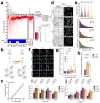A microenvironment-inspired synthetic three-dimensional model for pancreatic ductal adenocarcinoma organoids
- PMID: 34518665
- PMCID: PMC7612137
- DOI: 10.1038/s41563-021-01085-1
A microenvironment-inspired synthetic three-dimensional model for pancreatic ductal adenocarcinoma organoids
Abstract
Experimental in vitro models that capture pathophysiological characteristics of human tumours are essential for basic and translational cancer biology. Here, we describe a fully synthetic hydrogel extracellular matrix designed to elicit key phenotypic traits of the pancreatic environment in culture. To enable the growth of normal and cancerous pancreatic organoids from genetically engineered murine models and human patients, essential adhesive cues were empirically defined and replicated in the hydrogel scaffold, revealing a functional role of laminin-integrin α3/α6 signalling in establishment and survival of pancreatic organoids. Altered tissue stiffness-a hallmark of pancreatic cancer-was recapitulated in culture by adjusting the hydrogel properties to engage mechano-sensing pathways and alter organoid growth. Pancreatic stromal cells were readily incorporated into the hydrogels and replicated phenotypic traits characteristic of the tumour environment in vivo. This model therefore recapitulates a pathologically remodelled tumour microenvironment for studies of normal and pancreatic cancer cells in vitro.
© 2021. The Author(s), under exclusive licence to Springer Nature Limited.
Conflict of interest statement
LGG has patent application pending related to the hydrogel system. The rest of the authors have no competing interests to disclose.
Figures





Comment in
-
Synthetic tumor microenvironments.Nat Methods. 2021 Nov;18(11):1274. doi: 10.1038/s41592-021-01321-1. Nat Methods. 2021. PMID: 34732900 No abstract available.
-
Synthetic scaffold for pancreatic organoids.Nat Mater. 2022 Jan;21(1):9-11. doi: 10.1038/s41563-021-01177-y. Nat Mater. 2022. PMID: 34949871 No abstract available.
References
Publication types
MeSH terms
Substances
Grants and funding
LinkOut - more resources
Full Text Sources
Medical

